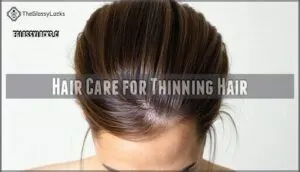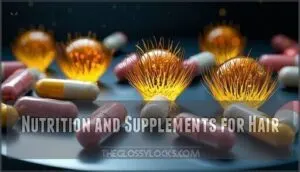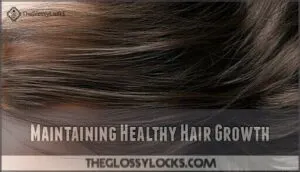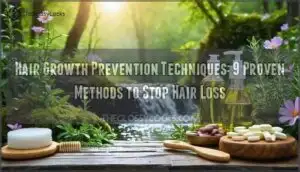This site is supported by our readers. We may earn a commission, at no cost to you, if you purchase through links.
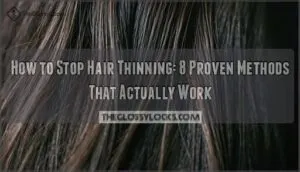
Start with a balanced diet rich in protein, iron, and vitamins—your hair follicles are like tiny factories that need proper fuel.
Use gentle shampoos, avoid tight hairstyles, and reduce heat styling.
Manage stress through exercise or meditation, since chronic stress literally pulls nutrients away from your scalp.
Consider proven treatments like minoxidil for regrowth.
Think of hair care like tending a garden—consistency beats quick fixes every time.
The key is catching thinning early and creating the right environment for healthy growth.
Table Of Contents
Key Takeaways
- Address the root cause – Start with a balanced diet rich in protein, iron, and vitamins since your hair follicles need proper fuel, and consider proven treatments like minoxidil for regrowth.
- Use gentle hair care practices – Switch to sulfate-free shampoos, avoid tight hairstyles and excessive heat styling, and treat your strands like delicate silk to prevent further damage.
- Manage stress consistently – Practice stress reduction through exercise or meditation since chronic stress pulls nutrients away from your scalp and disrupts normal hair growth cycles.
- Act early and stay consistent – Catch thinning early through regular monitoring, maintain your routine religiously, and remember that consistency beats quick fixes every time.
Causes of Hair Thinning
Understanding what causes your hair to thin is the first step toward stopping it.
Several factors can trigger hair thinning, including genetics, hormonal shifts, medical conditions, and certain medications or supplements.
Genetic Factors
Your family tree holds the blueprint for your hair’s future, with up to 80% of hereditary baldness cases stemming from genetic predisposition.
Male pattern baldness and androgenetic alopecia develop when your genes express sensitivity to DHT, creating a domino effect of follicle miniaturization.
While genetic testing can’t change your family history, understanding your hereditary hair loss risk enables proactive predisposition management through early DHT blockers like finasteride.
Hormonal Changes
Hormonal changes create a perfect storm for hair thinning, affecting both men and women at different life stages.
Androgen Levels spike during male pattern baldness, while women face Postpartum Thinning after childbirth and Menopause Hair loss as estrogen drops.
PCOS Impact includes elevated testosterone causing female hair loss.
Hormone Therapy can sometimes help restore balance and slow thinning.
Medical Conditions
Several medical conditions can trigger hair thinning causes beyond your control.
Thyroid impact from hypothyroidism or hyperthyroidism disrupts normal growth cycles, while autoimmune alopecia attacks healthy follicles directly.
Scalp conditions like seborrheic dermatitis create inflammation that weakens roots.
Hormonal imbalance from PCOS affects women substantially, and anemia effects reduce oxygen delivery to follicles.
Proper hair loss diagnosis identifies these underlying hair loss symptoms for targeted treatment.
Medications and Supplements
Certain medications and hair loss supplements can trigger unexpected thinning, making your hair care routine feel like walking through a minefield.
Common culprits include blood thinners, antidepressants, and chemotherapy drugs, while biotin for hair and other hair loss supplements may interfere with lab tests.
Nutrafol Men offers a drug-free hair supplement option for addressing thinning hair.
- Blood thinners and beta-blockers – Can disrupt normal hair growth cycles
- Antidepressants and mood stabilizers – May cause diffuse hair shedding
- Chemotherapy and immunosuppressants – Often cause temporary but significant hair loss
How to Stop Hair Thinning
Taking action against hair thinning requires a strategic approach that combines Early Detection with targeted interventions. You’ll need to identify the underlying causes first, whether they’re genetic, hormonal, or lifestyle-related.
Once you understand what’s driving your hair loss, you can implement effective hair thinning treatment options that address your specific situation. Managing Expectations becomes essential here—stopping hair thinning isn’t always immediate, but consistent effort with proven hair loss solutions can yield significant results.
Consistent scalp massages techniques can also help stimulate hair growth.
- Monitor your scalp daily for changes in hair density, texture, or shedding patterns to catch thinning early
- Adjust your diet to include protein, iron, and vitamins that support healthy hair growth from within
- Implement gentle hair care routines using sulfate-free products and avoiding excessive heat styling
- Consider medical interventions like minoxidil or finasteride after consulting with a healthcare professional
- Address underlying health issues such as thyroid problems or hormonal imbalances that contribute to thinning
Hair Loss Prevention
Preventing hair loss starts with understanding your personal risk factors and taking proactive steps before thinning becomes noticeable.
You’ll have the best results when you combine gentle hair care practices with proper nutrition, stress management, and protective measures that keep your existing hair healthy and strong.
Balanced Diet and Nutrition
Your diet acts as the foundation for healthy hair growth, supplying the building blocks your follicles need to thrive. Poor nutrition creates a domino effect, weakening hair from the root up.
Including foods rich in essential nutrients is vital for maintaining healthy hair growth. Nutrient Absorption depends on eating diverse, whole foods rather than relying solely on Supplement Choices.
Your Protein Intake should include lean meats, eggs, and legumes to support keratin production. Hydration Effects on hair become visible within weeks of increasing water consumption.
| Nutrient | Hair Benefits | Top Sources |
|---|---|---|
| Iron | Prevents excessive shedding | Spinach, lean beef, lentils |
| Biotin | Strengthens hair shaft | Eggs, nuts, sweet potatoes |
| Omega-3 | Adds shine and moisture | Salmon, walnuts, flaxseeds |
| Zinc | Regulates oil production | Shellfish, pumpkin seeds |
| Vitamin D | Stimulates new growth | Fatty fish, fortified foods |
The Dietary Impact on hair thinning causes becomes apparent after 2-3 months of consistent healthy hair diet changes, making hair loss nutrition a cornerstone of effective hair loss prevention.
Gentle Hair Care Practices
Nourishing your body properly sets the foundation, but how you handle your hair daily matters just as much.
Treat your strands like delicate silk—they deserve respect.
Switch to mild shampoos that won’t strip natural oils, and always apply heat protection before styling.
Give yourself scalp massages while shampooing to boost circulation.
Use soft brushes instead of harsh plastic ones, and remember hydration importance extends beyond drinking water—moisturized hair breaks less easily.
Reducing Stress and Anxiety
Under chronic stress, your body releases cortisol, which disrupts hair growth cycles and pushes follicles into resting phases prematurely.
Stress reduction techniques like mindfulness meditation, deep breathing exercises, and regular yoga can substantially improve hair thinning.
Quality sleep of 7-9 hours nightly helps regulate stress hormones, while anxiety management through counseling or relaxation methods supports healthy hair growth patterns naturally, promoting overall well-being through regular yoga.
Protecting Hair From Damage
Environmental aggressors constantly attack your hair follicles, weakening strands and accelerating thinning.
Heat styling tools, chemical treatments, and sun exposure create cumulative damage that disrupts growth cycles.
Tight styles pull at roots, while product buildup clogs follicles.
Shield your hair with gentle hair care practices, wear hats against ultraviolet light, and choose protective hairstyles that won’t stress your scalp, using methods that promote healthy growth.
Treatment Options Available
When gentle hair care and prevention methods aren’t enough to combat thinning, proven medical treatments can offer real results.
These evidence-based options range from FDA-approved medications that work at the follicle level to advanced procedures that relocate healthy hair to problem areas.
Minoxidil and Finasteride
Two FDA-approved medications can effectively combat hair thinning when prevention isn’t enough. Minoxidil efficacy shows improvement in 67% of users applying it twice daily, while finasteride side effects remain minimal for most men experiencing male pattern hair loss.
Many users find that minoxidil addresses thinning effectively.
- Minoxidil for hair: Apply topically twice daily for at least 4 months to see results
- Finasteride side effects: Rare but may include decreased libido in less than 2% of users
- Combined therapy: Using both medications together often yields better outcomes than single treatment
- Treatment duration: Requires ongoing use to maintain hair growth benefits
- Alternative options: Oral minoxidil available for cases where topical application isn’t practical
Hair Transplant Surgery
Hair transplant surgery moves healthy follicles from donor areas to thinning regions, offering permanent hair restoration.
Modern surgical techniques like FUE and FUT achieve excellent graft survival rates when performed by experienced surgeons.
The recovery process typically spans 2-3 weeks with minimal downtime.
However, potential risks include infection, scarring, and unnatural-looking results.
Understanding the overall procedure expenses is essential for financial planning.
Cost analysis reveals procedures range from $4,000-$15,000, making this hair loss solution a significant investment requiring careful consideration.
Low-Level Laser Therapy
Low-level laser therapy offers a non-invasive approach to combat hair thinning through targeted light wavelengths.
Clinical studies demonstrate LLLT effectiveness with 18-39% hair density improvements over 16-24 weeks.
Home devices provide convenient treatment options, though laser safety remains paramount—these cool-beam systems won’t burn your scalp.
Many people find success with LLLT hair thinning products, and while therapy cost varies substantially, FDA-approved devices guarantee reliable hair growth stimulation for androgenetic alopecia patients seeking proven hair thinning solutions.
Platelet-Rich Plasma Injections
Some might call it your body’s own fountain of youth for hair growth.
PRP therapy uses your blood’s concentrated platelets to deliver growth factors directly into hair follicles.
This injection technique stimulates dormant follicles and improves blood flow.
Treatment frequency typically involves three to six sessions spaced monthly, with maintenance every four to six months.
Side effects remain minimal—mild scalp tenderness and temporary redness.
Cost analysis shows sessions range from $400-$1,500 each, making this alopecia treatment a significant investment, with a notable financial commitment.
Hair Care for Thinning Hair
When your hair starts thinning, switching to the right care routine becomes your first line of defense. You’ll want to treat every strand like it’s precious because, frankly, it is.
Gentle Shampoos and Conditioners
With thinning hair, you’re walking a tightrope between cleansing and preserving what you have.
Sulfate-free shampoos won’t strip your scalp’s natural oils like harsh detergents do. Choose products with balanced pH levels that support scalp health while providing gentle hydration.
Essential features for hair thinning products:
- Sulfate-free formulas that cleanse without aggressive foaming
- Lightweight conditioners that won’t weigh down fragile strands
- Botanical ingredients like saw palmetto or biotin for follicle support
- pH-balanced formulations (4.5-6.5) that maintain scalp’s protective barrier
- Volumizing properties that create fullness without chemical buildup
Avoiding Heat Styling and Tight Hairstyles
Your hair’s daily routine shouldn’t feel like a battlefield against heat damage.
Excessive temperatures from styling tools weaken strands, while tight hairstyles cause traction alopecia.
Choose protective styles and hairstyle alternatives that embrace your natural texture instead of fighting it.
| Heat Damage Risks | Protective Styles | Styling Tools |
|---|---|---|
| Weakened hair cuticles | Loose braids | Wide-barrel brushes |
| Increased breakage | Low ponytails | Heat-free rollers |
| Follicle inflammation | Natural textures | Microfiber towels |
Using Detanglers and Wide-Tooth Combs
When dealing with fragile strands, your approach matters more than the products you choose. Wet detangling with gentle hair care techniques prevents unnecessary breakage reduction while maintaining healthy hair growth tips.
For easier management, remember to section damp hair.
- Choose protein-free detangler ingredients like glycerin or aloe vera that won’t weigh down thinning strands
- Select wide-tooth combs with smooth comb material such as seamless plastic or wood to minimize snags
- Start detangling from ends upward using gentle combing motions to avoid pulling from the roots
- Apply hair thickening products before wet detangling to create slip and protect vulnerable hair thinning remedies
Regular Trims and Hair Maintenance
Regular trims every 6-8 weeks prevent split ends from traveling up your hair shaft, protecting what’s left of your thinning strands.
Choose quality scissors and brush type matters – use boar bristle brushes for gentle detangling techniques.
Proper hydration importance extends beyond drinking water; scalp massages during hair treatments boost circulation.
Protective styling and gentle hair care habits minimize hair damage while maximizing growth potential.
Nutrition and Supplements for Hair
What you eat directly affects how your hair grows, and certain nutrients can make the difference between thick, healthy strands and continued thinning.
From essential vitamins that strengthen follicles to supplements that boost growth, the right nutritional approach can help restore your hair’s natural density.
Vitamin and Mineral Deficiencies
Nutritional gaps can sabotage your hair before you even notice.
Several different vitamins and mineral deficiencies can cause hair loss, with low levels of iron, zinc, and vitamin D frequently associated with various types of hair loss.
These shortfalls disrupt essential processes like cell turnover and oxygen delivery to follicles.
Critical deficiencies affecting hair health:
- Iron Deficiency – Limits oxygen transport to hair roots
- Vitamin D – Controls follicle growth cycles
- Zinc Benefits – Supports protein synthesis in strands
- Protein Intake – Provides structural building blocks
When you’re deficient, these processes are disrupted, and more hairs may enter the resting phase prematurely, leading to telogen effluvium marked by excessive hair shedding.
Biotin and Collagen Supplements
Beyond the marketing hype, biotin and collagen supplements show mixed results for hair loss prevention tips.
Clinical trials reveal biotin benefits only those with deficiencies, while collagen types demonstrate more promising absorption rates.
Supplement dosage matters—collagen shows measurable improvements in hair treatment outcomes, unlike biotin’s limited evidence in healthy individuals.
| Supplement | Effective Dosage | Clinical Evidence | Best For |
|---|---|---|---|
| Biotin | 30μg daily (deficiency cases: up to 30mg) | Limited in healthy individuals | Biotin deficiency only |
| Collagen | 2.5-10g daily | 27.6% density increase, 37.3% less shedding | Thinning hair in women |
| Combined | Follow individual recommendations | Insufficient data | Hair care tips enhancement |
| Timing | 3-6 months consistency required | Results vary by individual | Long-term hair products strategy |
Omega-3 Fatty Acids and Hair Growth
Among fish, walnuts, and flaxseeds, you’ll find omega-3 fatty acids that tackle scalp inflammation while delivering essential follicle nourishment.
These healthy fats boost hair thickness by improving blood circulation to your scalp.
Dietary sources like salmon and chia seeds work as natural hair loss remedies, supporting overall hair treatment efforts better than many expensive hair loss treatment options, utilizing essential follicle nourishment.
Hydration and Hair Health
Water serves as the foundation for healthy hair growth, with proper hydration directly impacting your hair’s strength and appearance.
Dehydrated hair becomes brittle and prone to breakage, accelerating thinning processes.
Your hydration strategy should include:
- Daily Water Intake – Consume 8-10 glasses to maintain ideal scalp moisture
- Scalp Hydration – Apply leave-in treatments to combat dry hair conditions
- Hair Elasticity – Well-hydrated strands stretch without snapping during styling
- Prevention Focus – Adequate hydration supports hair loss prevention and overall hair health
Medical Conditions and Hair Thinning
You’re not alone if you’ve noticed your hair thinning—several medical conditions can trigger hair loss, often without obvious symptoms.
Understanding the connection between your health and your hair can help you identify treatable causes and prevent further thinning, which is crucial for maintaining your hair’s health and addressing any underlying medical conditions.
Thyroid Disorders and Hair Loss
Thyroid disorders pack a double punch in relation to hair loss. Both hypothyroidism effects and hyperthyroidism impact disrupt your hair’s natural growth cycle, pushing follicles into premature rest mode.
This hormonal shake-up affects up to 50% of people with thyroid dysfunction.
| Condition | Hair Loss Pattern | Recovery Timeline |
|---|---|---|
| Hypothyroidism | Diffuse scalp thinning | 3-6 months with treatment |
| Hyperthyroidism | Widespread shedding | 4-8 months post-treatment |
| Hashimoto’s | Patchy loss with thinning | Variable, depends on thyroid antibodies |
The good news? Hormone replacement therapy typically reverses this process. When your thyroid levels normalize, your hair often bounces back stronger than before.
Autoimmune Disorders and Hair Loss
Autoimmune conditions can turn your immune system against your hair follicles.
Alopecia areata affects 2% of people, causing patchy hair loss when immune cells attack follicles.
Lupus erythematosus triggers diffuse thinning in up to 31% of patients during flares.
Hashimoto’s disease and psoriasis effects also contribute to hair loss causes through inflammation, making early medical intervention essential for managing these thinning hair conditions.
Skin Conditions and Hair Loss
Dealing with scalp conditions like Scalp Psoriasis, Seborrheic Dermatitis, Folliculitis, and Ringworm can directly trigger thinning hair.
These inflammatory conditions create an unhealthy scalp environment, disrupting normal hair growth cycles.
Scarring Alopecia, the most serious form, permanently damages follicles through chronic inflammation.
You’ll need targeted hair loss treatment options addressing both the underlying scalp conditions and resulting hair loss causes, including hair loss treatment.
Hormonal Imbalances and Hair Loss
Hormonal fluctuations can turn your hair follicles into unwilling participants in a complex biochemical dance.
When your hormones go haywire, your hair pays the price.
Estrogen decline during menopause reduces hair’s protective shield, while androgen excess and DHT sensitivity trigger androgenic alopecia and female pattern baldness.
PCOS impact creates additional hormonal chaos, causing thinning hair causes to multiply.
Hormone therapy can help rebalance these disrupted systems and restore normal growth cycles.
Diet and stress can also affect hair health, so reducing oxidative stress can be beneficial to improve overall hair health.
Maintaining Healthy Hair Growth
Once you’ve addressed underlying causes and established a treatment routine, maintaining consistent hair growth requires ongoing attention to your hair’s natural patterns and health.
Regular monitoring helps you catch changes early and adjust your approach before minor issues become major setbacks, which is crucial for maintaining overall hair health.
Regular Check-Ups and Monitoring
Regular check-ups with your doctor keep you ahead of the game in regards to hair loss monitoring.
Early detection through hair loss assessments can boost treatment efficacy substantially.
Most experts recommend hair loss screenings every six months if you’re experiencing thinning.
Your healthcare provider can create personalized plans based on hair loss evaluations, adjusting preventative measures as needed for ideal monitoring frequency.
Hair Growth Cycles and Patterns
Understanding your hair’s natural rhythm helps you spot what’s normal versus concerning.
Your Hair Follicles cycle through three distinct phases that determine when you’ll see shedding or regrowth.
Here’s how your hair moves through its growth journey:
- Anagen Phase – Active growth lasting 2-7 years, when Growth Factors fuel healthy strand development
- Catagen Stage – Brief interim period where follicles shrink and detach from blood supply
- Telogen Effluvium – Resting phase before shedding, affecting hair loss patterns and regrowth timing
Preventing Further Hair Loss
Once you’ve mastered your hair growth cycles, preventing further hair loss becomes your next priority.
Early intervention works best – don’t wait until thinning becomes severe. Review medications with your doctor, as some drugs accelerate hair loss risk factors.
Make lifestyle adjustments like quitting smoking and managing stress. Maintain scalp health through gentle cleansing and protective styling that doesn’t pull follicles.
Addressing potential nutritional deficiencies can also bolster hair health.
Promoting Hair Regrowth and Density
Once you’ve stopped further loss, promoting hair regrowth becomes your next goal.
Scalp stimulation through gentle massage boosts follicle health and circulation. Natural remedies like rosemary oil hair treatments can match minoxidil’s effectiveness.
Low-level laser therapy devices stimulate growth factors that increase hair thickness. Combining hair loss solutions and treatments creates the best environment for regrowth and utilizes gentle massage techniques.
Frequently Asked Questions (FAQs)
What are the big 3 for thinning hair?
The "big 3" for thinning hair are minoxidil (Rogaine), finasteride (Propecia), and ketoconazole shampoo.
These FDA-approved treatments target different causes: minoxidil stimulates growth, finasteride blocks DHT hormone, and ketoconazole reduces scalp inflammation.
How long does hair thinning recovery take?
You’ll usually see hair thinning start to improve within three to six months if you address the cause.
Think of it like waiting for grass to regrow—patience pays off, but steady care makes all the difference.
Can hair thinning be completely reversed naturally?
Hair thinning can’t be completely reversed naturally in most cases.
While stress-induced or nutritional hair loss may recover, genetic pattern baldness typically requires medical treatments like minoxidil or finasteride for effective results, often involving minoxidil.
When should I see a doctor about thinning?
Don’t let thinning hair become a wild goose chase — consult your doctor if you’re noticing sudden hair loss, patchy bald spots, or persistent shedding lasting over three months.
Is hair thinning different in men versus women?
Yes, hair thinning patterns differ between men and women. Men typically experience receding hairlines and crown balding, while women see diffuse thinning across the top, with their part gradually widening.
What age does hair thinning typically start?
About 30% of men experience noticeable thinning by age
Hair thinning typically starts in your twenties or thirties, though genetics can trigger it earlier or delay it until your forties and beyond.
Conclusion
Sarah discovered her hairline receding at 28 and felt devastated until she learned how to stop hair thinning through consistent action.
Remember, you’ve got multiple tools at your disposal—from nutrition and gentle care to proven treatments like minoxidil.
Your hair responds to patience, not panic.
Start with the basics: eat protein-rich foods, manage stress, and ditch harsh styling habits.
If you’re dealing with significant thinning, don’t hesitate to consult a dermatologist, because consistency trumps perfection every time.
- https://www.goodrx.com/conditions/hair-loss/most-common-causes-of-hair-loss
- https://my.clevelandclinic.org/health/diseases/16921-hair-loss-in-women
- https://www.mayoclinic.org/diseases-conditions/hair-loss/symptoms-causes/syc-20372926
- https://www.webmd.com/skin-problems-and-treatments/hair-loss/understanding-hair-loss-prevention
- https://www.reddit.com/r/finehair/comments/1ckvqcq/how_do_i_stop_my_hair_from_thinninggrow_it_thicker/







